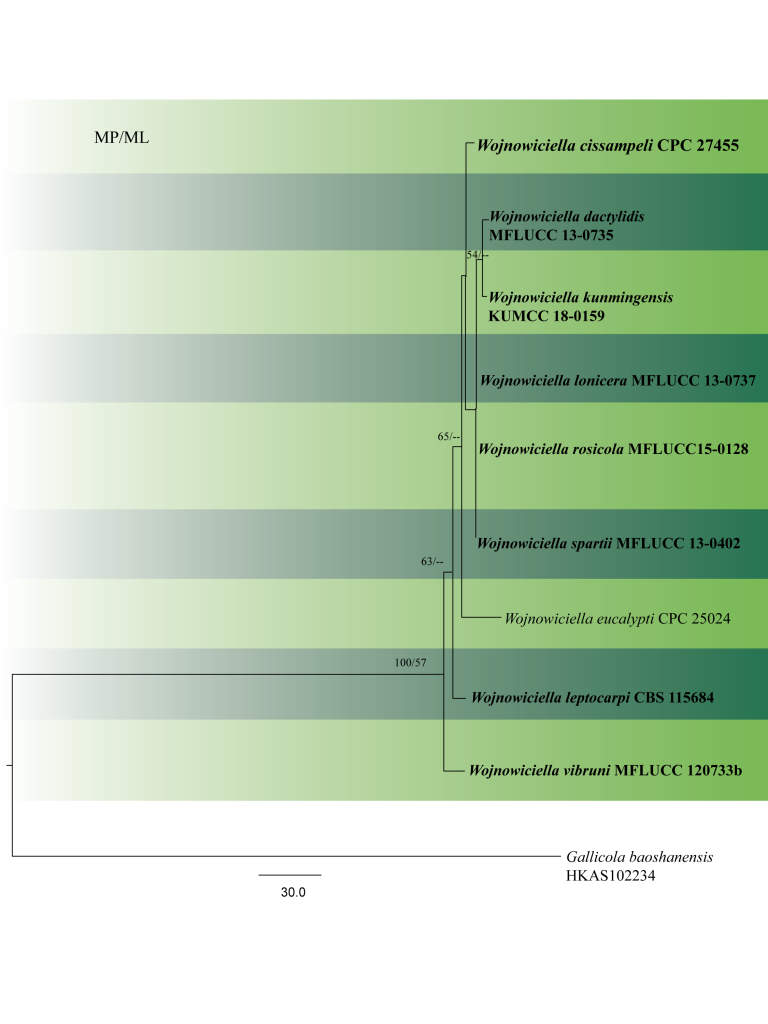27 Oct Wojnowiciella
Wojnowiciella Crous, Hern.-Restr.& M.J. Wingf., Persoonia 34, 201 (2015)
Background
Wojnowiciella was introduced by Crous et al. (2015) to include Wojnowiciella eucalypti which exhibited somewhat similar morphological characteristics to Wojnowicia, such as setose pycnidia, with ampulliform, enteroblastic, phialidic conidiogenous cells, but differed with apapillate conidiomata lacking setae and having dark brown conidia.
Classification – Ascomycota, Pezizomycota, Dothideomycetes, Pleosporales, Phaeosphaeriaceae
Type species – Wojnowiciella eucalypti Crous, Hern.-Restr. & M.J. Wingf
Distribution – Australia (Hernandez-Restrepo et al. 2016), China (Crous et al. 2015, Giraldo et al. 2017), Colombia (Crous et al. 2015, Giraldo et al. 2017), New Zealand (Crous et al. 2019), South Africa and Western Cape (Crous et al. 2016)
Disease symptoms – Leaf spots
Most species are reported as saprobes with the exception of Wojnowiciella cissampeli, W. eucalypti and W. vibruni which were isolated from leaves and twigs of Cissampelos capensis, Eucalyptus and Viburnum utile respectively (Hernandez-Restrepo et al. 2016). Their pathogenicity or disease symptoms are not indicated clearly and there is a need to establish pathogenicity of these species.
Hosts – Cissampelos capensis, Dactylis sp., Eucalyptus grandis, Rosa sp., Leptocarpus sp., Lonicera sp., Spartium sp. and Viburnum utile (Farr and Rossman 2020).
Morphological based identification and diversity
Wojnowiciella was introduced to include species that were phylogenetically distinct but morphologically similar to Wojnowicia (Crous et al. 2015). Wojnowiciella is characterized by apapillate conidiomata without setae and dark brown conidia. Some species of Wojnowiciella also produce hyaline microconidia. Karunarathna et al. (2017) first reported the sexual morph of W. dactylidis. Phookamsak et al. (2019) transferred Wojnowicia rosicola to Wojnowiciella rosicola based on morphology and phylogenetic analyses.
Molecular based identification and diversity
Wojnowiciella is a well-supported genus in the family Phaeosphaeriaceae (Phookamsak et al. 2019). A combined multiloci phylogeny of LSU, SSU, tef1 and ITS is used in placing species of Wojnowiciella within Phaeosphaeriaceae. To identify species within the genus ITS, LSU, rpb2 and tef1 are used (Marlin-Felix 2019; Phookamsak et al. 2019). Here we provide an updated phylogenetic tree for this genus (Fig. 1).
Recommended genetic markers (genus level) – LSU
Recommended genetic markers (species level) – ITS, rpb2, tef1
Accepted number of species – Nine species are accepted with molecular data (Table 1).
References – Crous et al. 2015, Karunarathna et al. 2017, Marlin-Felix 2019, Phookamsak et al. 2019 (morphology and phylogeny)
Table 1 Details of Wojnowiciella, isolates used in the phylogenetic analyses. Ex-type (or ex-epitype) strains are in bold and marked with an asterisk* and voucher strains are in bold.
| Species | Isolates | ITS | LSU | tef1 | References |
| Wojnowiciella cissampeli | CBS 141297* | KX228272 | KX228323
|
LT990616
|
Crous et al. (2016) |
| W. dactylidis | MFLUCC 13-0735* | KP744470 | KP684149 | – | Liu et al. (2015) |
| W. eucalypti | CBS 139904* | KR476741 | KR476774 | LT990617 | Crous et al. (2015) |
| W. kunmingensis | KUMCC18-0159* | MK356380 | MK356354 | MK359071 | Phookamsak et al. (2019) |
| W. leptocarpi | CBS 115684* | KX306775 | KX306800 | LT990615 | Hernandez-Restrepo et al. (2016) |
| W. lonicerae | MFLUCC 13-0737* | KP744471 | KP684151 | – | Liu et al. (2015) |
| W. rosicola | MFLUCC 15-0128* | MG828979 | MG829091 | – | Phookamsak et al. (2019) |
| W. spartii | MFLUCC 13-0402* | KU058719 | KU058729 | – | Li et al. (2015) |
| W. viburni | MFLUCC 12-0733* | KC594286 | KC594287 | – | Wijayawardene et al. (2013) |
Fig. 1 Phylogram generated from MP analysis based on combined sequences of ITS, LSU and tef1 sequences of all the accepted species of Wojnowiciella. Related sequences were obtained from GenBank. Ten taxa are included in the analyses, which comprise 2460 characters including gaps. Single gene analyses were carried out and compared with each species, to compare the topology of the tree and clade stability. The tree was rooted with Galiicola baoshanensis (HKAS102234). The best scoring RAxML tree with a final likelihood value of – 6772.195394 is presented. The matrix had 261 distinct alignment patterns, with 0.96% of undetermined characters or gaps. Estimated base frequencies were as follows: A = 0.230657, C = 0.279364, G = 0.252128, T = 0.237852; substitution rates AC = 1.388608, AG = 2.845402, AT = 2.389715, CG = 0.838197, CT = 7.220493, GT = 1.000000; gamma distribution shape parameter a = 0.650385. ML and MP bootstrap support value ≥50% are shown respectively near the nodes. Ex-type strains are in bold


No Comments